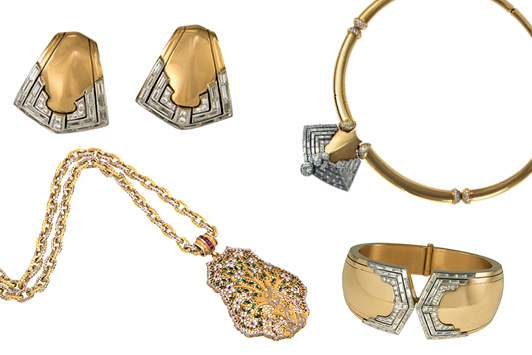
What could possibly follow as a second career for a former Harvard fellow who had spent 25 years working as a foreign-policy specialist? For Mahnaz Ispahani, it was jewelry. In 2013, she created the Mahnaz Collection, featuring design-oriented vintage pieces from the mid- to late 20th century.
Although it all started when she wanted to replace a stone in her engagement ring, Ispahani admits to a longstanding passion for jewelry. “Jewelry was a fairly cultivated interest for a long time,” she says, adding that her sister wondered why it had taken her so long.
Of Pakistani and Iranian descent, Ispahani approaches curating with a cultured eye and a deep sense of history. “I come from a place where jewelry is very much a part of everyday life and every ritual moment in a woman’s life. Even a poor woman working in the fields will wear a bracelet which has meaning to her,” she says.
For Ispahani, whose family experienced the violent revolutions in Bangladesh and Iran, “jewelry is another way to look at the world. It reminds everyone — including myself — that even though there may be ugliness in the world, human beings are capable of creating beautiful things like jewelry.”
Delving into design
While beauty is the quality that Ispahani considers first when selecting a piece, design is the most important criterion. And it’s not just how the jewelry is made, she says, but the entire conception of the piece that intrigues her, which harks back to her early training. She will not sell a piece until all her questions are answered.
“I take a fairly historical and scholarly approach to jewelry,” she explains. “How much does it tell us about the time in which it was made? How innovative was the process? What materials were used? Why, for example, did designers start using yellow gold in the ’70s?”
The Mahnaz Collection features works made by high houses, artists, independent jewelers and goldsmiths. Her vintage and contemporary Hopi, Navajo and Pueblo modernist jewelry collection reflects her interest in landscape and her personal connection to the American Southwest, where she has traveled extensively.
The turquoise in the jewelry holds a special attraction. “[It] relates very much to my Persian heritage,” she notes, while pointing out that the preferred Persian turquoise is not veined like the type Native American jewelers admire.
The swinging ’60s
The swinging ’60s stands out as one of Ispahani’s favorite eras. “It inspired jewelers to respond to the times by being more open, experimental and organic. It was also a time for more wearable jewelry when semiprecious stones became important.”
The era broadened people’s horizons in the ’70s. “People became interested in India again — not like Cartier’s relationship to the maharajas, but in a different way, a more fundamental and deep connection,” she explains.
The jewelry reflected the creativity of the times, unlike the lack of expression that she sees in current jewelry. “It is almost as if we have a fear of personality. Maybe it’s because the world is unsettled and people are too cautious,” says Ispahani.
She considers the Mahnaz Collection to be the sum of all her experiences.
“It is not so much politics, but culture and human relationships that connect countries and places,” she says. “My background has given me an appreciation for all cultures.”
And even as she continues discovering exquisite pieces, there is still a stone missing in her engagement ring.
Image: Mahnaz Ispahani collection of vintage and contemporary jewels.Article from the Rapaport Magazine - March 2018. To subscribe click here.